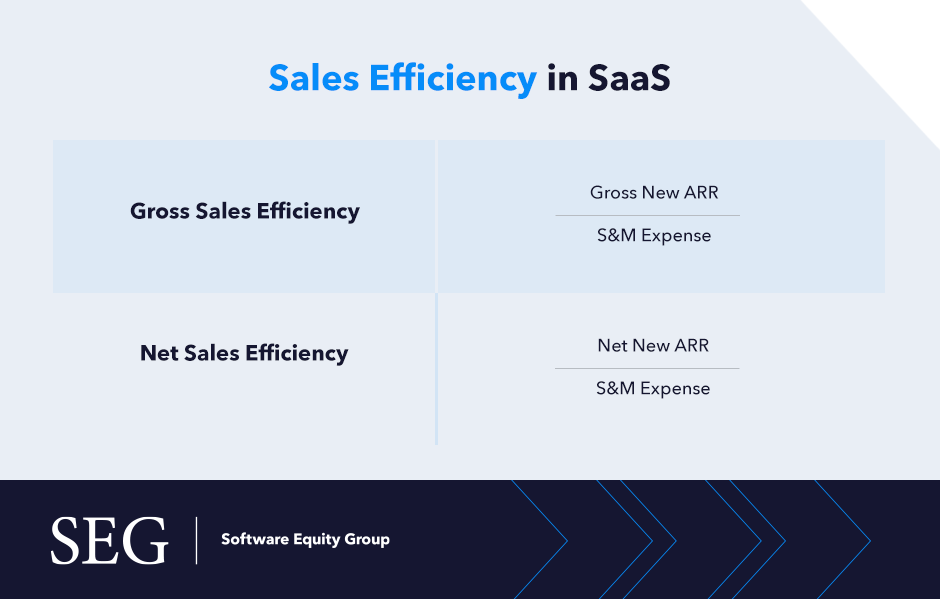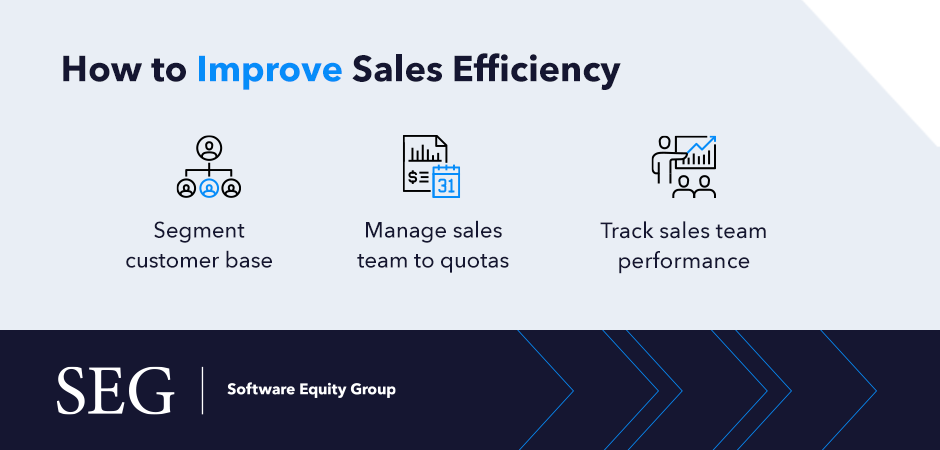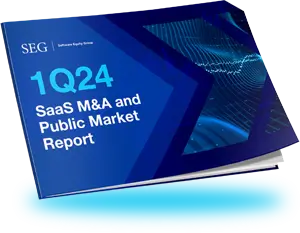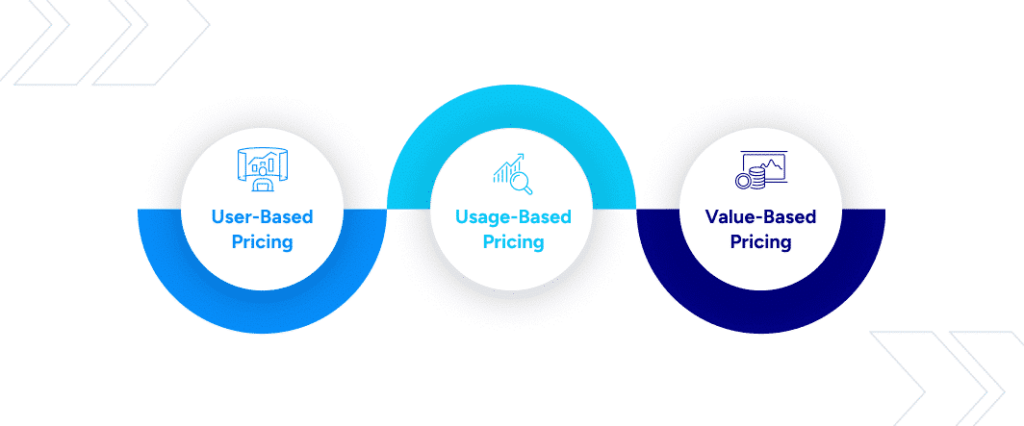The Importance of Sales Efficiency to SaaS M&A (And How to Calculate It Properly)

For SaaS companies seeking to sell or raise capital, growth is a major component of valuation. Revenue and ARR growth are a function of how effective your sales model is or the return on your sales and marketing spend. Sales efficiency is particularly important in M&A because it indicates the potential for long-term growth and profitability.
In our webinar, Private Equity Perspectives on B2B SaaS Investing, we asked leading software & SaaS investors to identify three key metrics they focus on to assess the health of a company’s sales and marketing efforts. Their answer: customer acquisition cost (CAC), lifetime value (LTV), and sales efficiency.
We delved into the importance of lifetime value and customer acquisition in our recent blog, The Importance of LTV:CAC for SaaS Businesses, but we’re now focusing on the sales efficiency ratio – an entirely different metric. Learn why it’s a key indicator of future growth prospects and how to measure your sales efficiency ratio.
What Is Sales Efficiency?
Sales efficiency is a powerful metric in the SaaS industry, calculating how well your business performs its main task: selling software. Your sales efficiency ratio shows your company’s revenue generated per dollar of sales and marketing expenses during a given period. For example, a sales efficiency ratio of .77 means you see $0.77 in new revenue for every $1.00 your sales and marketing team spends.
The sales efficiency ratio provides both historical views on the effectiveness of your sales and marketing spending and insights for future business decisions. Depending on your sales efficiency ratio, you may decide to increase spending or re-evaluate your sales and marketing efforts.
Knowing how efficiently your company generates new revenue allows you to compare your go-to-market engine with industry benchmarks and understand how you fare against competitors. Potential investors and strategic buyers also use your sales efficiency ratio when analyzing the strengths and opportunities within your business.
Calculating Sales Efficiency in SaaS
By regularly tracking sales efficiency, you can see insights into how it trends over time to assess and adjust your sales and marketing strategy. With better insight into historical data and industry benchmarks, your software company can properly allocate resources to boost sales efficiency, increase revenue, and improve the value of the business in the eyes of prospective buyers.
There are several ways to calculate sales efficiency in SaaS. Gross sales efficiency looks at incremental revenue generated over a fixed period, while net sales efficiency offsets this revenue by any loss in customer revenue due to churn over the same timeframe.

Gross Sales Efficiency
Gross sales efficiency only focuses on annual recurring revenue (ARR) generated in the previous period. It does not account for any down-selling or churn your business experiences. Without these adjustments, you get a clear view of the efficiency of your sales and marketing actions.
To calculate your gross sales efficiency ratio, you must first determine your gross new annual recurring revenue. You can measure this amount for any period of time by subtracting the recurring revenue at the end of the period from the beginning of the period.
Gross New ARR = Ending Quarter ARR – Beginning Quarter ARR
Then simply divide your gross new ARR for the period by your sales and marketing expenses from the same timeframe. These expenses include salaries, benefits, commissions, software, advertising expenses, and other related costs.
Gross Sales Efficiency = Gross New ARR / S&M Expense
Net Sales Efficiency
Net sales efficiency accounts for lost business in addition to new sales, isolating the total new amount of ARR added. If your net sales efficiency is significantly better than your gross sales efficiency, it is a signal that poor retention is weighing down your ability to increase top line ARR.
To determine your net sales efficiency ratio, you first need to calculate your net new ARR. This figure is found by subtracting your lost ARR of a period from your ARR of the same period.
Net New ARR = (Ending Period ARR – Beginning Period ARR) – Lost and Contracted ARR
Once you have this figure, divide your net new ARR by your sales and marketing expenses of the same period to calculate your net sales efficiency.
Net Sales Efficiency = Net New ARR / S&M Expense
Your sales and marketing expenses should remain the same, regardless of which metric is being calculated.
| Quarter | ARR | Lost ARR | S&M Expense | Gross Sales Efficiency | Net Sales Efficiency |
| Q1 | $500,000 | $60,000 | $50,000 | – | – |
| Q2 | $570,000 | $30,000 | $50,000 | 1.4 | 2 |
| Q3 | $625,000 | $10,000 | $50,000 | 1.1 | 1.3 |
| Q4 | $725,000 | $50,000 | $70,000 | 1.42 | 2.14 |
SaaS Magic Number
Comparing your sales efficiency with industry benchmarks or competitors can be difficult as their ARR, sales and marketing spend, or other key figures aren’t always public knowledge. The SaaS magic number calculation helps you overcome this problem, replacing ARR with generally accepted accounting principle (GAAP) revenue. GAAP revenue has standardized reporting, so the information shared is consistent and accurate.
To measure this ratio, replace the net new ARR with the difference in GAAP between periods. Divide this amount by the sales and marketing expenses to determine the ratio.
SaaS Magic Number = (GAAP Revenue Current Period – GAAP Revenue Previous Period) x 4] / Sales and Marketing Expenditure Previous Period
Incorporate Sales Efficiency Into Your Sales and Marketing Strategy
Once you’ve calculated your sales efficiency ratio, you can compare it in-house over time to track how it is trending in line with efforts. You can also measure your sales efficiency ratio against industry averages to assess your efficiency and overall performance.
SaaS industry benchmarks find a sales efficiency ratio between .75 and 1.0 acceptable. Companies in this range are considered moderately efficient but may have room to improve.
If your sales efficiency ratio is less than 1.0, you may want to revisit your sales and marketing strategy, including opportunities to upsell or cross-sell. A sales efficiency ratio below .75 indicates inefficiencies within your business that need to be addressed. Without fixing these problems, your profitability and growth can suffer.
Sales efficiency is an important indicator of how effective your sales and marketing efforts are and how efficiently your organization can grow. Actively reviewing and recrafting sales strategy to boost efficiency is an important aspect of managing your growth and ultimately maximizing valuation in a liquidity event.
How to Improve Sales Efficiency

If you need to prioritize improving your sales efficiency, here are a few ways to boost your ratio:
- Segment Your Customer Base. Analyze and allocate resources to the most valuable portions. This can also allow you to segment your sales team to focus on specific verticals, bifurcate hunters versus farmers, etc.
- Manage Your Sales Team to Quotas / Goals. Managing your sales team with reasonable, clear goals in mind can help you measure their success. Goals that can drive efficiency can include an amount of new sales, upsells or cross-sells, or revenue targets for workers to meet each month. Assessing how well they are meeting these goals can help you help them increase their time spent on selling your software. Monitor if they are spending time on tasks that don’t fit your revenue generation goals, like data entry or attending meetings.
- Track Sales Team Performance. Constantly track sales team performance and productivity to ensure that the best salespeople are spending time on the highest value/return aspects of the business and so that lower performing team members can be given the attention and tools necessary to succeed.
Having a high sales efficiency ratio or improving the metric over time indicates your company’s ability to sustainably and efficiently scale into future growth and profitability. Putting in the time and effort to develop your sales efficiency early on helps attract future investors and puts you on the right track for exit planning.
Reach out to our experienced M&A advisors if you have questions about calculating sales efficiency or how to leverage your sales efficiency ratio to achieve your personal or business objectives.













